Strategic Management & Leadership: Sainsbury's Strategy Evaluation
VerifiedAdded on 2022/12/30
|23
|7602
|30
Report
AI Summary
This report provides a detailed analysis of Sainsbury's strategic management and leadership. It begins with an executive summary outlining the relationships between strategy, stakeholder expectations, and organizational performance, using strategic management theory. The report then evaluates the impact of external factors, particularly economic, political, and cultural, on Sainsbury's. Based on this analysis, a new strategy is formulated to address challenges and meet organizational objectives, with a critical evaluation and justification. The report also explores how the strategy encourages innovation and change, comparing it to competing strategies. An implementation plan is developed to fulfill stakeholder expectations. The second part of the report analyzes Sainsbury's current organizational structure and evaluates its effectiveness, proposing and evaluating a restructure plan. The report concludes with recommendations and a discussion of the key findings.
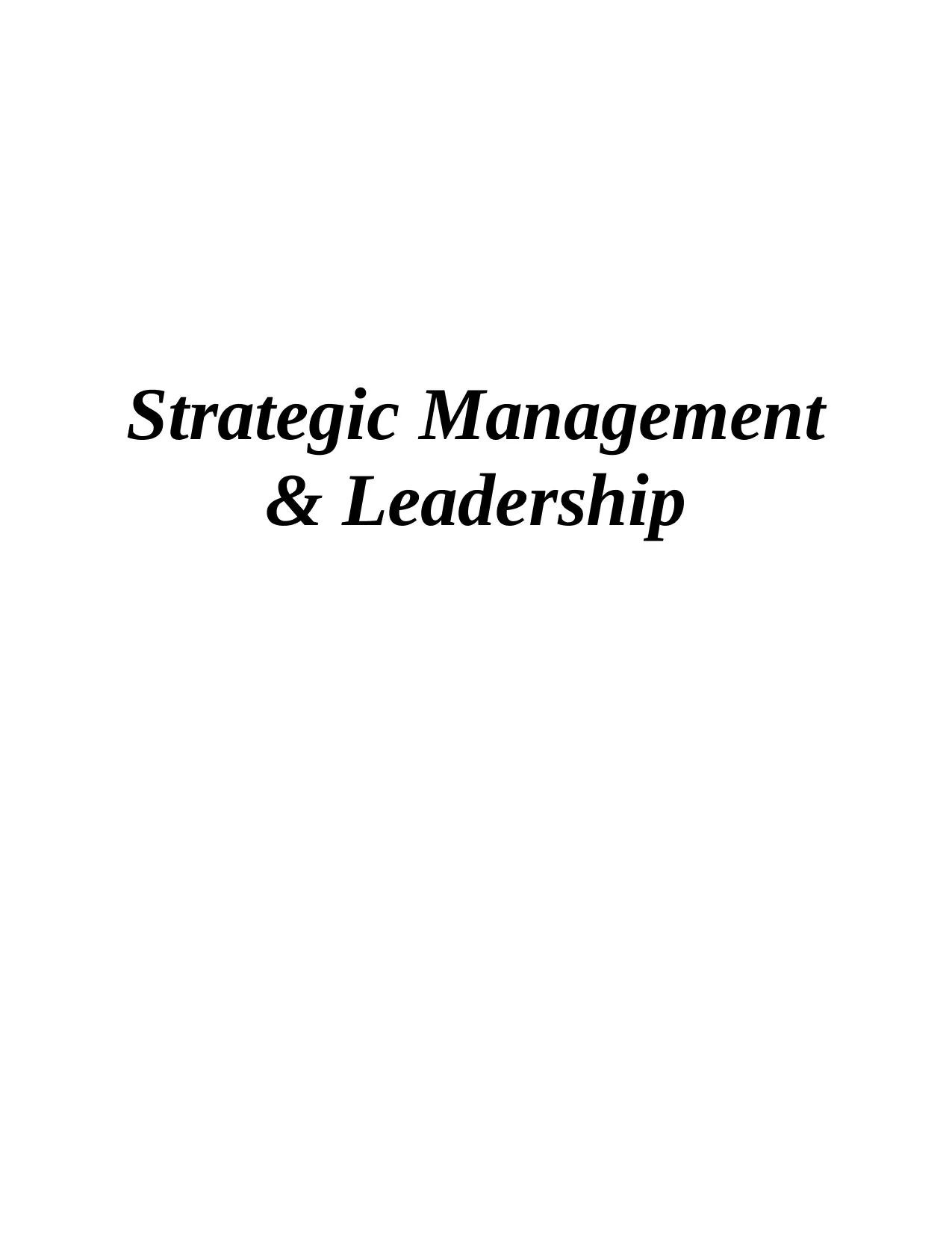
Strategic Management
& Leadership
& Leadership
Paraphrase This Document
Need a fresh take? Get an instant paraphrase of this document with our AI Paraphraser
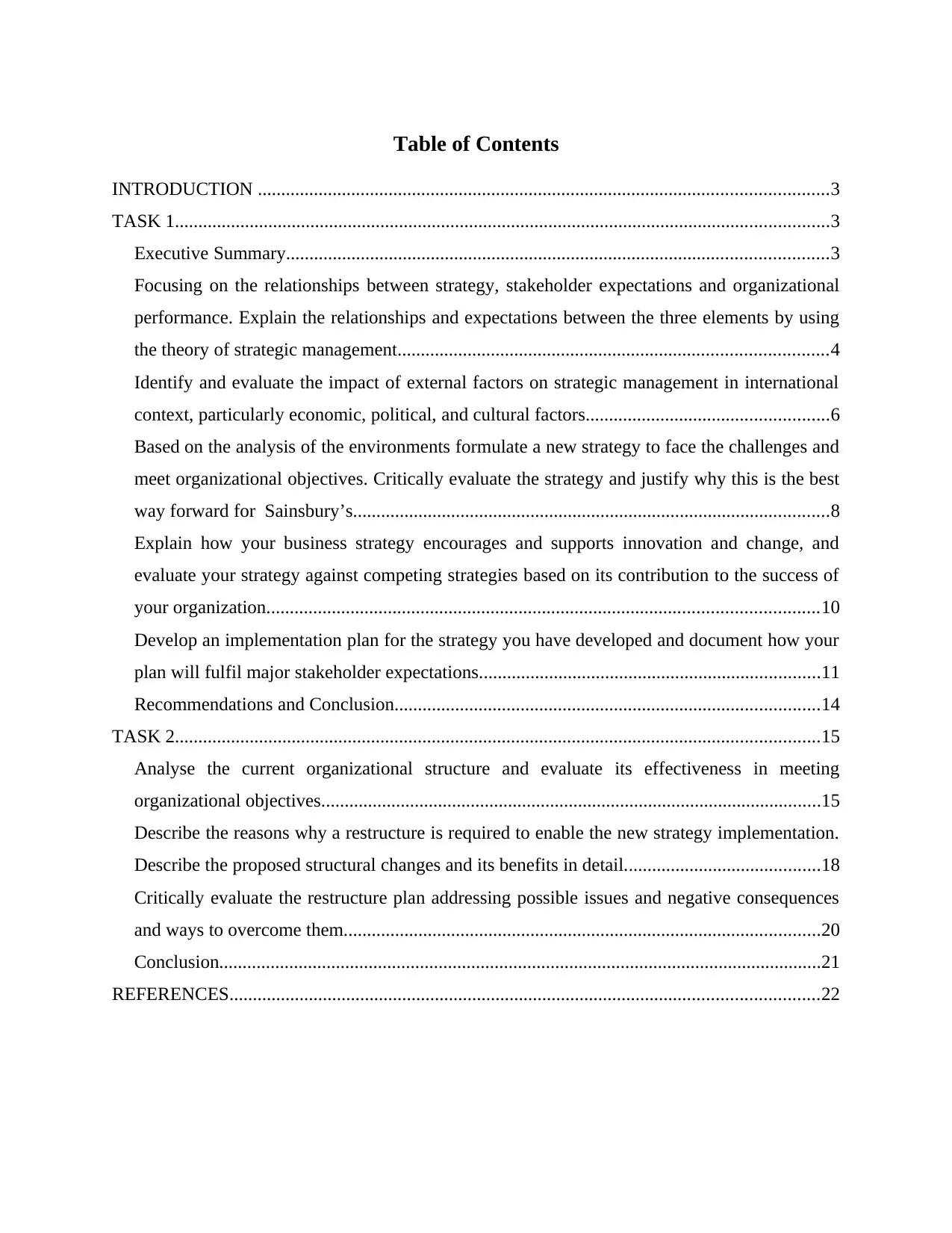
Table of Contents
INTRODUCTION ..........................................................................................................................3
TASK 1............................................................................................................................................3
Executive Summary....................................................................................................................3
Focusing on the relationships between strategy, stakeholder expectations and organizational
performance. Explain the relationships and expectations between the three elements by using
the theory of strategic management............................................................................................4
Identify and evaluate the impact of external factors on strategic management in international
context, particularly economic, political, and cultural factors....................................................6
Based on the analysis of the environments formulate a new strategy to face the challenges and
meet organizational objectives. Critically evaluate the strategy and justify why this is the best
way forward for Sainsbury’s......................................................................................................8
Explain how your business strategy encourages and supports innovation and change, and
evaluate your strategy against competing strategies based on its contribution to the success of
your organization......................................................................................................................10
Develop an implementation plan for the strategy you have developed and document how your
plan will fulfil major stakeholder expectations.........................................................................11
Recommendations and Conclusion...........................................................................................14
TASK 2..........................................................................................................................................15
Analyse the current organizational structure and evaluate its effectiveness in meeting
organizational objectives...........................................................................................................15
Describe the reasons why a restructure is required to enable the new strategy implementation.
Describe the proposed structural changes and its benefits in detail..........................................18
Critically evaluate the restructure plan addressing possible issues and negative consequences
and ways to overcome them......................................................................................................20
Conclusion.................................................................................................................................21
REFERENCES..............................................................................................................................22
INTRODUCTION ..........................................................................................................................3
TASK 1............................................................................................................................................3
Executive Summary....................................................................................................................3
Focusing on the relationships between strategy, stakeholder expectations and organizational
performance. Explain the relationships and expectations between the three elements by using
the theory of strategic management............................................................................................4
Identify and evaluate the impact of external factors on strategic management in international
context, particularly economic, political, and cultural factors....................................................6
Based on the analysis of the environments formulate a new strategy to face the challenges and
meet organizational objectives. Critically evaluate the strategy and justify why this is the best
way forward for Sainsbury’s......................................................................................................8
Explain how your business strategy encourages and supports innovation and change, and
evaluate your strategy against competing strategies based on its contribution to the success of
your organization......................................................................................................................10
Develop an implementation plan for the strategy you have developed and document how your
plan will fulfil major stakeholder expectations.........................................................................11
Recommendations and Conclusion...........................................................................................14
TASK 2..........................................................................................................................................15
Analyse the current organizational structure and evaluate its effectiveness in meeting
organizational objectives...........................................................................................................15
Describe the reasons why a restructure is required to enable the new strategy implementation.
Describe the proposed structural changes and its benefits in detail..........................................18
Critically evaluate the restructure plan addressing possible issues and negative consequences
and ways to overcome them......................................................................................................20
Conclusion.................................................................................................................................21
REFERENCES..............................................................................................................................22
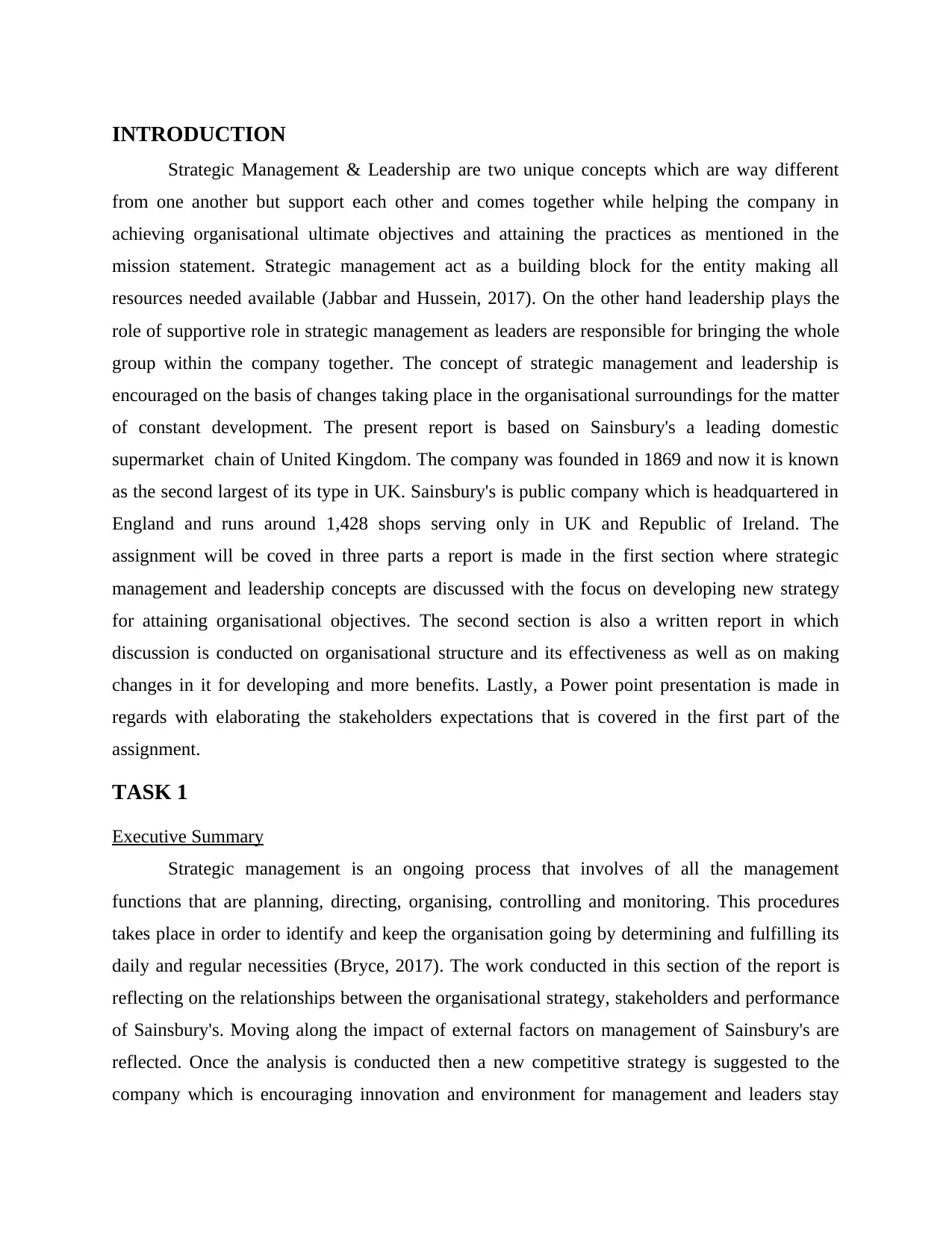
INTRODUCTION
Strategic Management & Leadership are two unique concepts which are way different
from one another but support each other and comes together while helping the company in
achieving organisational ultimate objectives and attaining the practices as mentioned in the
mission statement. Strategic management act as a building block for the entity making all
resources needed available (Jabbar and Hussein, 2017). On the other hand leadership plays the
role of supportive role in strategic management as leaders are responsible for bringing the whole
group within the company together. The concept of strategic management and leadership is
encouraged on the basis of changes taking place in the organisational surroundings for the matter
of constant development. The present report is based on Sainsbury's a leading domestic
supermarket chain of United Kingdom. The company was founded in 1869 and now it is known
as the second largest of its type in UK. Sainsbury's is public company which is headquartered in
England and runs around 1,428 shops serving only in UK and Republic of Ireland. The
assignment will be coved in three parts a report is made in the first section where strategic
management and leadership concepts are discussed with the focus on developing new strategy
for attaining organisational objectives. The second section is also a written report in which
discussion is conducted on organisational structure and its effectiveness as well as on making
changes in it for developing and more benefits. Lastly, a Power point presentation is made in
regards with elaborating the stakeholders expectations that is covered in the first part of the
assignment.
TASK 1
Executive Summary
Strategic management is an ongoing process that involves of all the management
functions that are planning, directing, organising, controlling and monitoring. This procedures
takes place in order to identify and keep the organisation going by determining and fulfilling its
daily and regular necessities (Bryce, 2017). The work conducted in this section of the report is
reflecting on the relationships between the organisational strategy, stakeholders and performance
of Sainsbury's. Moving along the impact of external factors on management of Sainsbury's are
reflected. Once the analysis is conducted then a new competitive strategy is suggested to the
company which is encouraging innovation and environment for management and leaders stay
Strategic Management & Leadership are two unique concepts which are way different
from one another but support each other and comes together while helping the company in
achieving organisational ultimate objectives and attaining the practices as mentioned in the
mission statement. Strategic management act as a building block for the entity making all
resources needed available (Jabbar and Hussein, 2017). On the other hand leadership plays the
role of supportive role in strategic management as leaders are responsible for bringing the whole
group within the company together. The concept of strategic management and leadership is
encouraged on the basis of changes taking place in the organisational surroundings for the matter
of constant development. The present report is based on Sainsbury's a leading domestic
supermarket chain of United Kingdom. The company was founded in 1869 and now it is known
as the second largest of its type in UK. Sainsbury's is public company which is headquartered in
England and runs around 1,428 shops serving only in UK and Republic of Ireland. The
assignment will be coved in three parts a report is made in the first section where strategic
management and leadership concepts are discussed with the focus on developing new strategy
for attaining organisational objectives. The second section is also a written report in which
discussion is conducted on organisational structure and its effectiveness as well as on making
changes in it for developing and more benefits. Lastly, a Power point presentation is made in
regards with elaborating the stakeholders expectations that is covered in the first part of the
assignment.
TASK 1
Executive Summary
Strategic management is an ongoing process that involves of all the management
functions that are planning, directing, organising, controlling and monitoring. This procedures
takes place in order to identify and keep the organisation going by determining and fulfilling its
daily and regular necessities (Bryce, 2017). The work conducted in this section of the report is
reflecting on the relationships between the organisational strategy, stakeholders and performance
of Sainsbury's. Moving along the impact of external factors on management of Sainsbury's are
reflected. Once the analysis is conducted then a new competitive strategy is suggested to the
company which is encouraging innovation and environment for management and leaders stay
⊘ This is a preview!⊘
Do you want full access?
Subscribe today to unlock all pages.

Trusted by 1+ million students worldwide
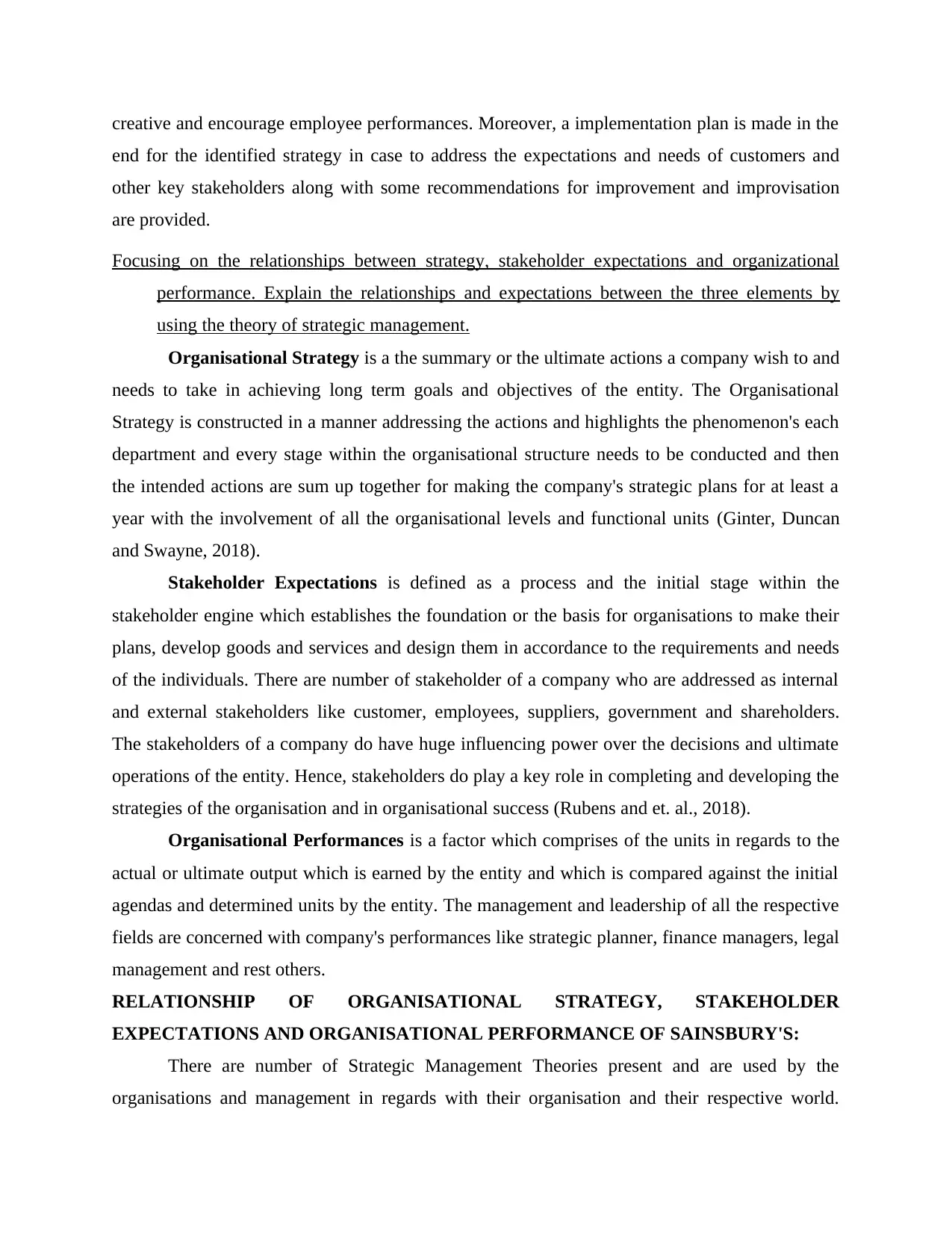
creative and encourage employee performances. Moreover, a implementation plan is made in the
end for the identified strategy in case to address the expectations and needs of customers and
other key stakeholders along with some recommendations for improvement and improvisation
are provided.
Focusing on the relationships between strategy, stakeholder expectations and organizational
performance. Explain the relationships and expectations between the three elements by
using the theory of strategic management.
Organisational Strategy is a the summary or the ultimate actions a company wish to and
needs to take in achieving long term goals and objectives of the entity. The Organisational
Strategy is constructed in a manner addressing the actions and highlights the phenomenon's each
department and every stage within the organisational structure needs to be conducted and then
the intended actions are sum up together for making the company's strategic plans for at least a
year with the involvement of all the organisational levels and functional units (Ginter, Duncan
and Swayne, 2018).
Stakeholder Expectations is defined as a process and the initial stage within the
stakeholder engine which establishes the foundation or the basis for organisations to make their
plans, develop goods and services and design them in accordance to the requirements and needs
of the individuals. There are number of stakeholder of a company who are addressed as internal
and external stakeholders like customer, employees, suppliers, government and shareholders.
The stakeholders of a company do have huge influencing power over the decisions and ultimate
operations of the entity. Hence, stakeholders do play a key role in completing and developing the
strategies of the organisation and in organisational success (Rubens and et. al., 2018).
Organisational Performances is a factor which comprises of the units in regards to the
actual or ultimate output which is earned by the entity and which is compared against the initial
agendas and determined units by the entity. The management and leadership of all the respective
fields are concerned with company's performances like strategic planner, finance managers, legal
management and rest others.
RELATIONSHIP OF ORGANISATIONAL STRATEGY, STAKEHOLDER
EXPECTATIONS AND ORGANISATIONAL PERFORMANCE OF SAINSBURY'S:
There are number of Strategic Management Theories present and are used by the
organisations and management in regards with their organisation and their respective world.
end for the identified strategy in case to address the expectations and needs of customers and
other key stakeholders along with some recommendations for improvement and improvisation
are provided.
Focusing on the relationships between strategy, stakeholder expectations and organizational
performance. Explain the relationships and expectations between the three elements by
using the theory of strategic management.
Organisational Strategy is a the summary or the ultimate actions a company wish to and
needs to take in achieving long term goals and objectives of the entity. The Organisational
Strategy is constructed in a manner addressing the actions and highlights the phenomenon's each
department and every stage within the organisational structure needs to be conducted and then
the intended actions are sum up together for making the company's strategic plans for at least a
year with the involvement of all the organisational levels and functional units (Ginter, Duncan
and Swayne, 2018).
Stakeholder Expectations is defined as a process and the initial stage within the
stakeholder engine which establishes the foundation or the basis for organisations to make their
plans, develop goods and services and design them in accordance to the requirements and needs
of the individuals. There are number of stakeholder of a company who are addressed as internal
and external stakeholders like customer, employees, suppliers, government and shareholders.
The stakeholders of a company do have huge influencing power over the decisions and ultimate
operations of the entity. Hence, stakeholders do play a key role in completing and developing the
strategies of the organisation and in organisational success (Rubens and et. al., 2018).
Organisational Performances is a factor which comprises of the units in regards to the
actual or ultimate output which is earned by the entity and which is compared against the initial
agendas and determined units by the entity. The management and leadership of all the respective
fields are concerned with company's performances like strategic planner, finance managers, legal
management and rest others.
RELATIONSHIP OF ORGANISATIONAL STRATEGY, STAKEHOLDER
EXPECTATIONS AND ORGANISATIONAL PERFORMANCE OF SAINSBURY'S:
There are number of Strategic Management Theories present and are used by the
organisations and management in regards with their organisation and their respective world.
Paraphrase This Document
Need a fresh take? Get an instant paraphrase of this document with our AI Paraphraser
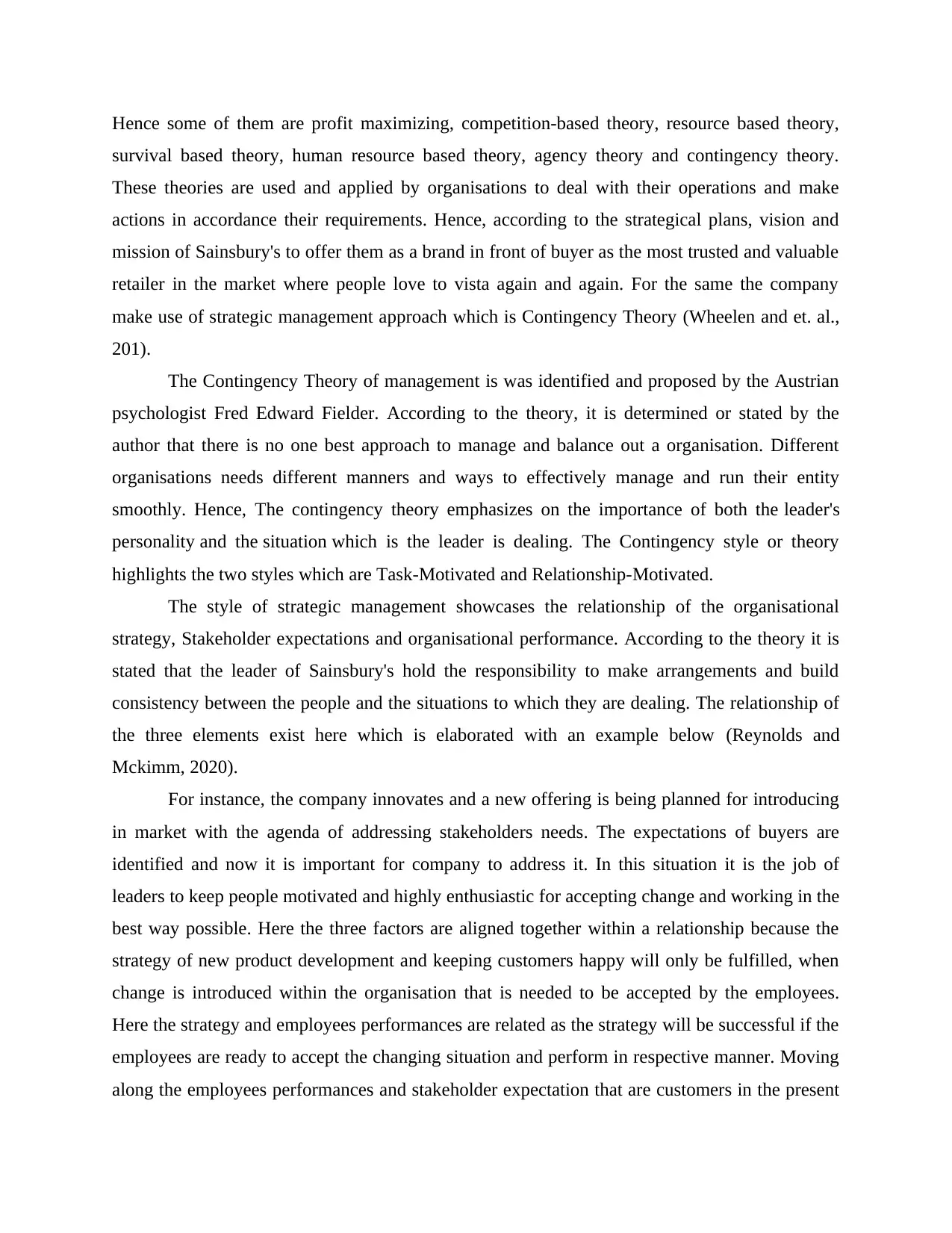
Hence some of them are profit maximizing, competition‐based theory, resource based theory,
survival based theory, human resource based theory, agency theory and contingency theory.
These theories are used and applied by organisations to deal with their operations and make
actions in accordance their requirements. Hence, according to the strategical plans, vision and
mission of Sainsbury's to offer them as a brand in front of buyer as the most trusted and valuable
retailer in the market where people love to vista again and again. For the same the company
make use of strategic management approach which is Contingency Theory (Wheelen and et. al.,
201).
The Contingency Theory of management is was identified and proposed by the Austrian
psychologist Fred Edward Fielder. According to the theory, it is determined or stated by the
author that there is no one best approach to manage and balance out a organisation. Different
organisations needs different manners and ways to effectively manage and run their entity
smoothly. Hence, The contingency theory emphasizes on the importance of both the leader's
personality and the situation which is the leader is dealing. The Contingency style or theory
highlights the two styles which are Task-Motivated and Relationship-Motivated.
The style of strategic management showcases the relationship of the organisational
strategy, Stakeholder expectations and organisational performance. According to the theory it is
stated that the leader of Sainsbury's hold the responsibility to make arrangements and build
consistency between the people and the situations to which they are dealing. The relationship of
the three elements exist here which is elaborated with an example below (Reynolds and
Mckimm, 2020).
For instance, the company innovates and a new offering is being planned for introducing
in market with the agenda of addressing stakeholders needs. The expectations of buyers are
identified and now it is important for company to address it. In this situation it is the job of
leaders to keep people motivated and highly enthusiastic for accepting change and working in the
best way possible. Here the three factors are aligned together within a relationship because the
strategy of new product development and keeping customers happy will only be fulfilled, when
change is introduced within the organisation that is needed to be accepted by the employees.
Here the strategy and employees performances are related as the strategy will be successful if the
employees are ready to accept the changing situation and perform in respective manner. Moving
along the employees performances and stakeholder expectation that are customers in the present
survival based theory, human resource based theory, agency theory and contingency theory.
These theories are used and applied by organisations to deal with their operations and make
actions in accordance their requirements. Hence, according to the strategical plans, vision and
mission of Sainsbury's to offer them as a brand in front of buyer as the most trusted and valuable
retailer in the market where people love to vista again and again. For the same the company
make use of strategic management approach which is Contingency Theory (Wheelen and et. al.,
201).
The Contingency Theory of management is was identified and proposed by the Austrian
psychologist Fred Edward Fielder. According to the theory, it is determined or stated by the
author that there is no one best approach to manage and balance out a organisation. Different
organisations needs different manners and ways to effectively manage and run their entity
smoothly. Hence, The contingency theory emphasizes on the importance of both the leader's
personality and the situation which is the leader is dealing. The Contingency style or theory
highlights the two styles which are Task-Motivated and Relationship-Motivated.
The style of strategic management showcases the relationship of the organisational
strategy, Stakeholder expectations and organisational performance. According to the theory it is
stated that the leader of Sainsbury's hold the responsibility to make arrangements and build
consistency between the people and the situations to which they are dealing. The relationship of
the three elements exist here which is elaborated with an example below (Reynolds and
Mckimm, 2020).
For instance, the company innovates and a new offering is being planned for introducing
in market with the agenda of addressing stakeholders needs. The expectations of buyers are
identified and now it is important for company to address it. In this situation it is the job of
leaders to keep people motivated and highly enthusiastic for accepting change and working in the
best way possible. Here the three factors are aligned together within a relationship because the
strategy of new product development and keeping customers happy will only be fulfilled, when
change is introduced within the organisation that is needed to be accepted by the employees.
Here the strategy and employees performances are related as the strategy will be successful if the
employees are ready to accept the changing situation and perform in respective manner. Moving
along the employees performances and stakeholder expectation that are customers in the present
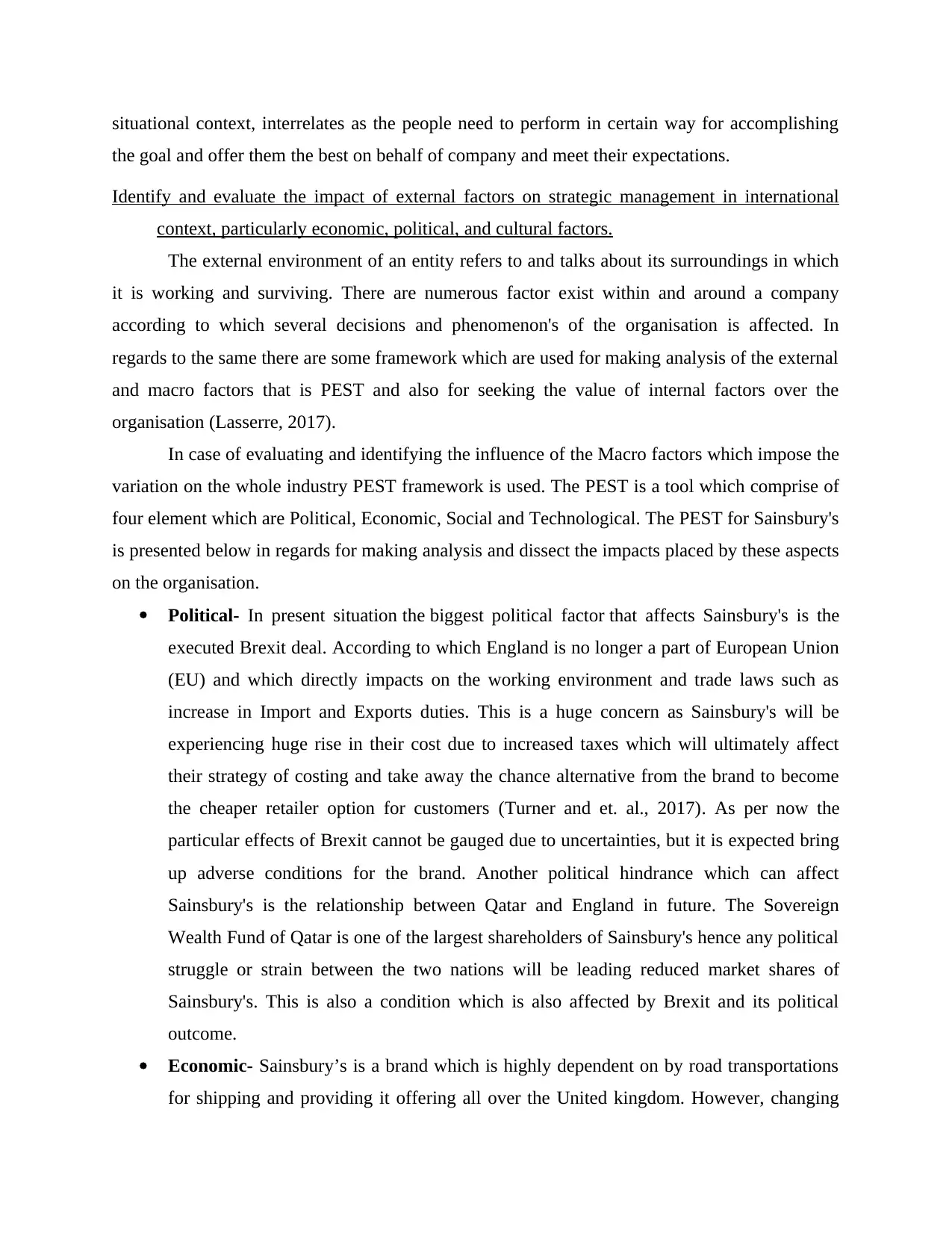
situational context, interrelates as the people need to perform in certain way for accomplishing
the goal and offer them the best on behalf of company and meet their expectations.
Identify and evaluate the impact of external factors on strategic management in international
context, particularly economic, political, and cultural factors.
The external environment of an entity refers to and talks about its surroundings in which
it is working and surviving. There are numerous factor exist within and around a company
according to which several decisions and phenomenon's of the organisation is affected. In
regards to the same there are some framework which are used for making analysis of the external
and macro factors that is PEST and also for seeking the value of internal factors over the
organisation (Lasserre, 2017).
In case of evaluating and identifying the influence of the Macro factors which impose the
variation on the whole industry PEST framework is used. The PEST is a tool which comprise of
four element which are Political, Economic, Social and Technological. The PEST for Sainsbury's
is presented below in regards for making analysis and dissect the impacts placed by these aspects
on the organisation.
Political- In present situation the biggest political factor that affects Sainsbury's is the
executed Brexit deal. According to which England is no longer a part of European Union
(EU) and which directly impacts on the working environment and trade laws such as
increase in Import and Exports duties. This is a huge concern as Sainsbury's will be
experiencing huge rise in their cost due to increased taxes which will ultimately affect
their strategy of costing and take away the chance alternative from the brand to become
the cheaper retailer option for customers (Turner and et. al., 2017). As per now the
particular effects of Brexit cannot be gauged due to uncertainties, but it is expected bring
up adverse conditions for the brand. Another political hindrance which can affect
Sainsbury's is the relationship between Qatar and England in future. The Sovereign
Wealth Fund of Qatar is one of the largest shareholders of Sainsbury's hence any political
struggle or strain between the two nations will be leading reduced market shares of
Sainsbury's. This is also a condition which is also affected by Brexit and its political
outcome.
Economic- Sainsbury’s is a brand which is highly dependent on by road transportations
for shipping and providing it offering all over the United kingdom. However, changing
the goal and offer them the best on behalf of company and meet their expectations.
Identify and evaluate the impact of external factors on strategic management in international
context, particularly economic, political, and cultural factors.
The external environment of an entity refers to and talks about its surroundings in which
it is working and surviving. There are numerous factor exist within and around a company
according to which several decisions and phenomenon's of the organisation is affected. In
regards to the same there are some framework which are used for making analysis of the external
and macro factors that is PEST and also for seeking the value of internal factors over the
organisation (Lasserre, 2017).
In case of evaluating and identifying the influence of the Macro factors which impose the
variation on the whole industry PEST framework is used. The PEST is a tool which comprise of
four element which are Political, Economic, Social and Technological. The PEST for Sainsbury's
is presented below in regards for making analysis and dissect the impacts placed by these aspects
on the organisation.
Political- In present situation the biggest political factor that affects Sainsbury's is the
executed Brexit deal. According to which England is no longer a part of European Union
(EU) and which directly impacts on the working environment and trade laws such as
increase in Import and Exports duties. This is a huge concern as Sainsbury's will be
experiencing huge rise in their cost due to increased taxes which will ultimately affect
their strategy of costing and take away the chance alternative from the brand to become
the cheaper retailer option for customers (Turner and et. al., 2017). As per now the
particular effects of Brexit cannot be gauged due to uncertainties, but it is expected bring
up adverse conditions for the brand. Another political hindrance which can affect
Sainsbury's is the relationship between Qatar and England in future. The Sovereign
Wealth Fund of Qatar is one of the largest shareholders of Sainsbury's hence any political
struggle or strain between the two nations will be leading reduced market shares of
Sainsbury's. This is also a condition which is also affected by Brexit and its political
outcome.
Economic- Sainsbury’s is a brand which is highly dependent on by road transportations
for shipping and providing it offering all over the United kingdom. However, changing
⊘ This is a preview!⊘
Do you want full access?
Subscribe today to unlock all pages.

Trusted by 1+ million students worldwide
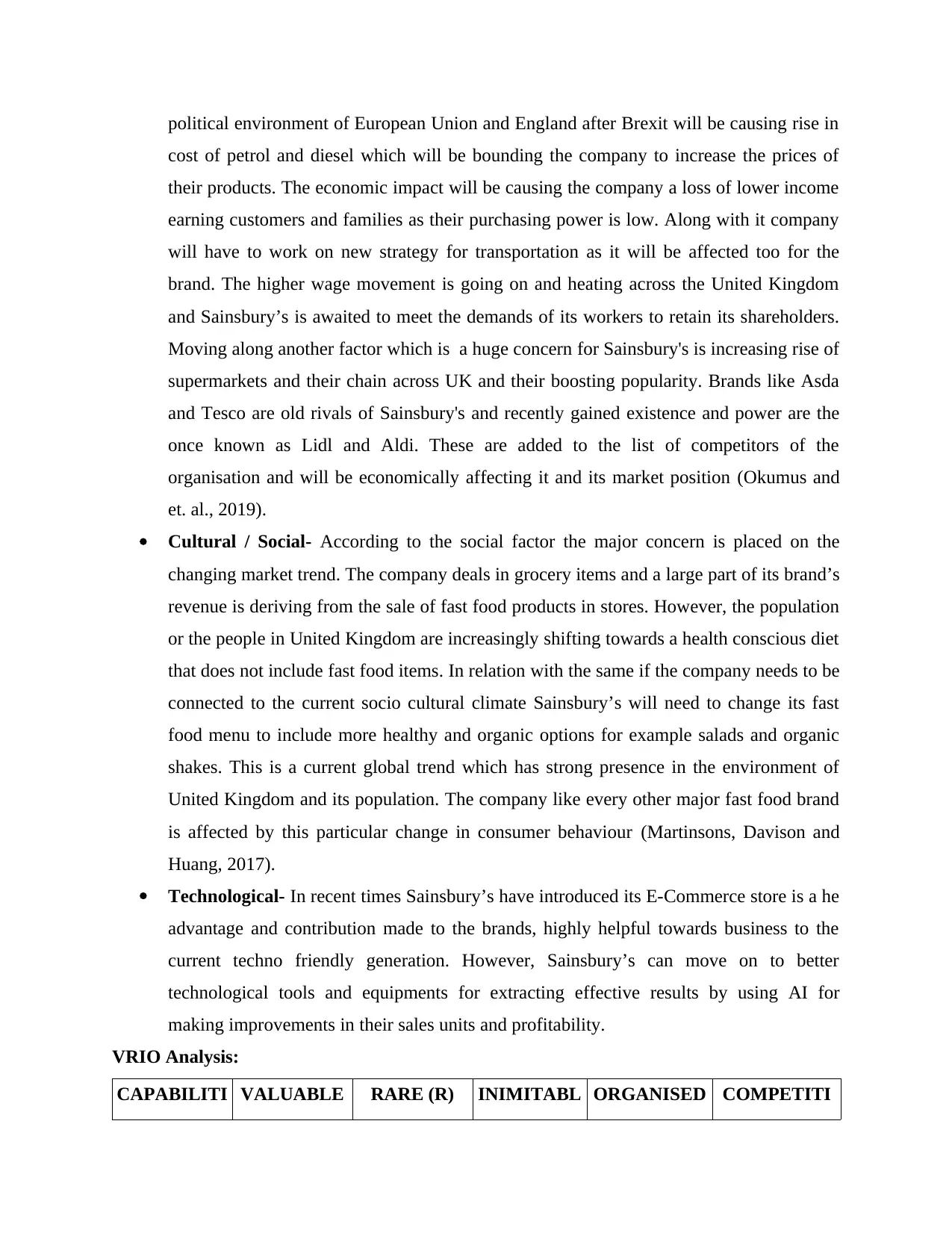
political environment of European Union and England after Brexit will be causing rise in
cost of petrol and diesel which will be bounding the company to increase the prices of
their products. The economic impact will be causing the company a loss of lower income
earning customers and families as their purchasing power is low. Along with it company
will have to work on new strategy for transportation as it will be affected too for the
brand. The higher wage movement is going on and heating across the United Kingdom
and Sainsbury’s is awaited to meet the demands of its workers to retain its shareholders.
Moving along another factor which is a huge concern for Sainsbury's is increasing rise of
supermarkets and their chain across UK and their boosting popularity. Brands like Asda
and Tesco are old rivals of Sainsbury's and recently gained existence and power are the
once known as Lidl and Aldi. These are added to the list of competitors of the
organisation and will be economically affecting it and its market position (Okumus and
et. al., 2019).
Cultural / Social- According to the social factor the major concern is placed on the
changing market trend. The company deals in grocery items and a large part of its brand’s
revenue is deriving from the sale of fast food products in stores. However, the population
or the people in United Kingdom are increasingly shifting towards a health conscious diet
that does not include fast food items. In relation with the same if the company needs to be
connected to the current socio cultural climate Sainsbury’s will need to change its fast
food menu to include more healthy and organic options for example salads and organic
shakes. This is a current global trend which has strong presence in the environment of
United Kingdom and its population. The company like every other major fast food brand
is affected by this particular change in consumer behaviour (Martinsons, Davison and
Huang, 2017).
Technological- In recent times Sainsbury’s have introduced its E-Commerce store is a he
advantage and contribution made to the brands, highly helpful towards business to the
current techno friendly generation. However, Sainsbury’s can move on to better
technological tools and equipments for extracting effective results by using AI for
making improvements in their sales units and profitability.
VRIO Analysis:
CAPABILITI VALUABLE RARE (R) INIMITABL ORGANISED COMPETITI
cost of petrol and diesel which will be bounding the company to increase the prices of
their products. The economic impact will be causing the company a loss of lower income
earning customers and families as their purchasing power is low. Along with it company
will have to work on new strategy for transportation as it will be affected too for the
brand. The higher wage movement is going on and heating across the United Kingdom
and Sainsbury’s is awaited to meet the demands of its workers to retain its shareholders.
Moving along another factor which is a huge concern for Sainsbury's is increasing rise of
supermarkets and their chain across UK and their boosting popularity. Brands like Asda
and Tesco are old rivals of Sainsbury's and recently gained existence and power are the
once known as Lidl and Aldi. These are added to the list of competitors of the
organisation and will be economically affecting it and its market position (Okumus and
et. al., 2019).
Cultural / Social- According to the social factor the major concern is placed on the
changing market trend. The company deals in grocery items and a large part of its brand’s
revenue is deriving from the sale of fast food products in stores. However, the population
or the people in United Kingdom are increasingly shifting towards a health conscious diet
that does not include fast food items. In relation with the same if the company needs to be
connected to the current socio cultural climate Sainsbury’s will need to change its fast
food menu to include more healthy and organic options for example salads and organic
shakes. This is a current global trend which has strong presence in the environment of
United Kingdom and its population. The company like every other major fast food brand
is affected by this particular change in consumer behaviour (Martinsons, Davison and
Huang, 2017).
Technological- In recent times Sainsbury’s have introduced its E-Commerce store is a he
advantage and contribution made to the brands, highly helpful towards business to the
current techno friendly generation. However, Sainsbury’s can move on to better
technological tools and equipments for extracting effective results by using AI for
making improvements in their sales units and profitability.
VRIO Analysis:
CAPABILITI VALUABLE RARE (R) INIMITABL ORGANISED COMPETITI
Paraphrase This Document
Need a fresh take? Get an instant paraphrase of this document with our AI Paraphraser
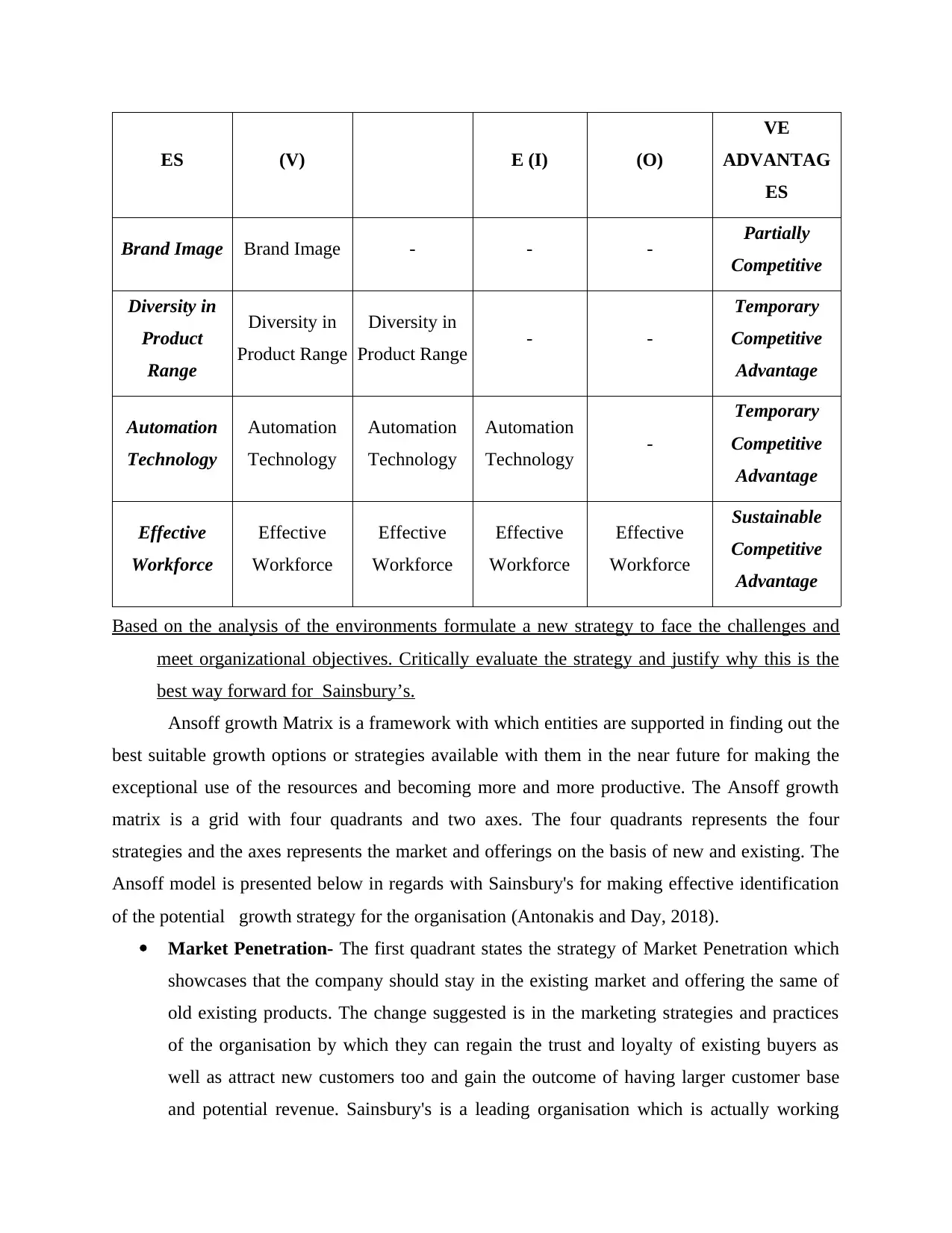
ES (V) E (I) (O)
VE
ADVANTAG
ES
Brand Image Brand Image - - - Partially
Competitive
Diversity in
Product
Range
Diversity in
Product Range
Diversity in
Product Range - -
Temporary
Competitive
Advantage
Automation
Technology
Automation
Technology
Automation
Technology
Automation
Technology -
Temporary
Competitive
Advantage
Effective
Workforce
Effective
Workforce
Effective
Workforce
Effective
Workforce
Effective
Workforce
Sustainable
Competitive
Advantage
Based on the analysis of the environments formulate a new strategy to face the challenges and
meet organizational objectives. Critically evaluate the strategy and justify why this is the
best way forward for Sainsbury’s.
Ansoff growth Matrix is a framework with which entities are supported in finding out the
best suitable growth options or strategies available with them in the near future for making the
exceptional use of the resources and becoming more and more productive. The Ansoff growth
matrix is a grid with four quadrants and two axes. The four quadrants represents the four
strategies and the axes represents the market and offerings on the basis of new and existing. The
Ansoff model is presented below in regards with Sainsbury's for making effective identification
of the potential growth strategy for the organisation (Antonakis and Day, 2018).
Market Penetration- The first quadrant states the strategy of Market Penetration which
showcases that the company should stay in the existing market and offering the same of
old existing products. The change suggested is in the marketing strategies and practices
of the organisation by which they can regain the trust and loyalty of existing buyers as
well as attract new customers too and gain the outcome of having larger customer base
and potential revenue. Sainsbury's is a leading organisation which is actually working
VE
ADVANTAG
ES
Brand Image Brand Image - - - Partially
Competitive
Diversity in
Product
Range
Diversity in
Product Range
Diversity in
Product Range - -
Temporary
Competitive
Advantage
Automation
Technology
Automation
Technology
Automation
Technology
Automation
Technology -
Temporary
Competitive
Advantage
Effective
Workforce
Effective
Workforce
Effective
Workforce
Effective
Workforce
Effective
Workforce
Sustainable
Competitive
Advantage
Based on the analysis of the environments formulate a new strategy to face the challenges and
meet organizational objectives. Critically evaluate the strategy and justify why this is the
best way forward for Sainsbury’s.
Ansoff growth Matrix is a framework with which entities are supported in finding out the
best suitable growth options or strategies available with them in the near future for making the
exceptional use of the resources and becoming more and more productive. The Ansoff growth
matrix is a grid with four quadrants and two axes. The four quadrants represents the four
strategies and the axes represents the market and offerings on the basis of new and existing. The
Ansoff model is presented below in regards with Sainsbury's for making effective identification
of the potential growth strategy for the organisation (Antonakis and Day, 2018).
Market Penetration- The first quadrant states the strategy of Market Penetration which
showcases that the company should stay in the existing market and offering the same of
old existing products. The change suggested is in the marketing strategies and practices
of the organisation by which they can regain the trust and loyalty of existing buyers as
well as attract new customers too and gain the outcome of having larger customer base
and potential revenue. Sainsbury's is a leading organisation which is actually working
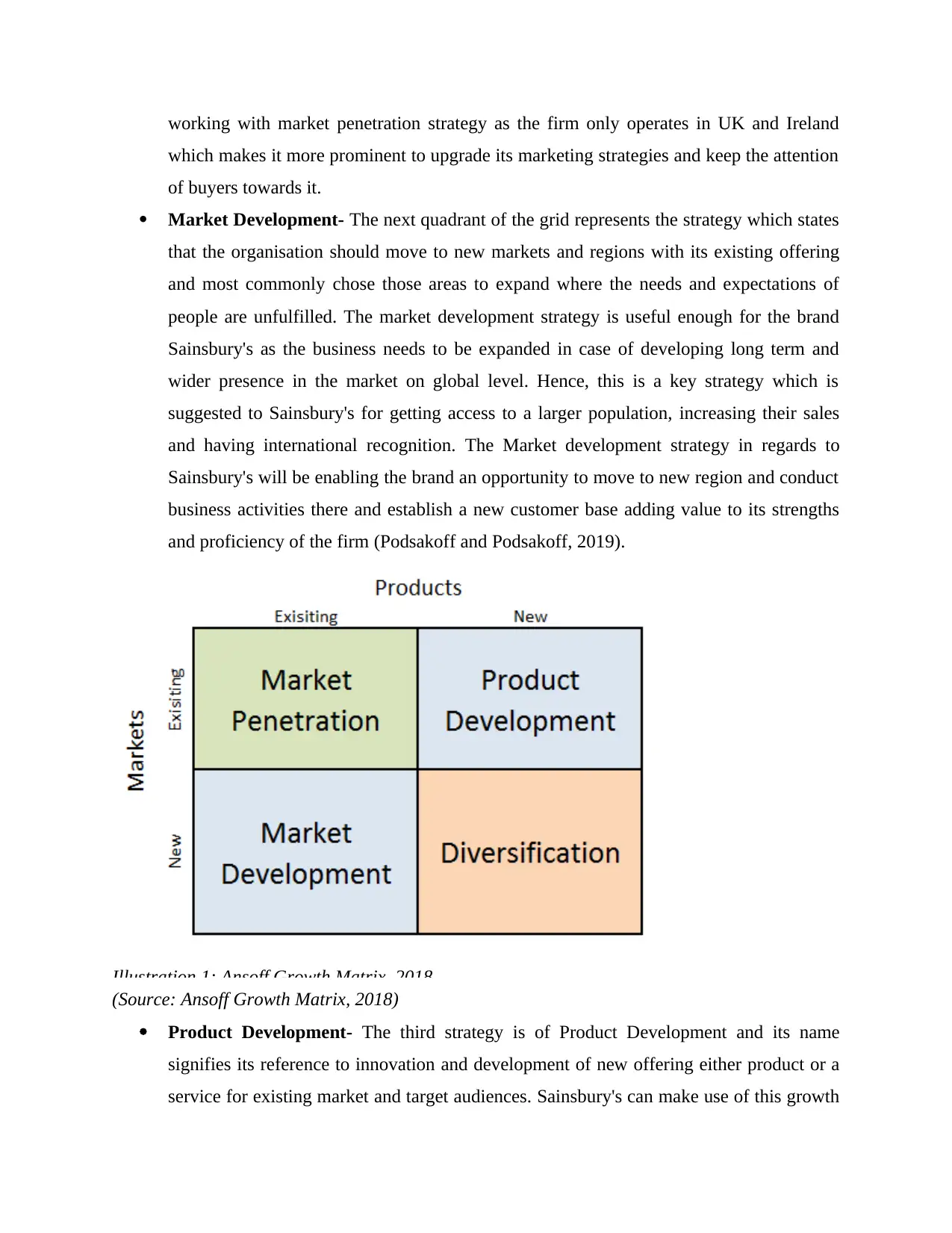
working with market penetration strategy as the firm only operates in UK and Ireland
which makes it more prominent to upgrade its marketing strategies and keep the attention
of buyers towards it.
Market Development- The next quadrant of the grid represents the strategy which states
that the organisation should move to new markets and regions with its existing offering
and most commonly chose those areas to expand where the needs and expectations of
people are unfulfilled. The market development strategy is useful enough for the brand
Sainsbury's as the business needs to be expanded in case of developing long term and
wider presence in the market on global level. Hence, this is a key strategy which is
suggested to Sainsbury's for getting access to a larger population, increasing their sales
and having international recognition. The Market development strategy in regards to
Sainsbury's will be enabling the brand an opportunity to move to new region and conduct
business activities there and establish a new customer base adding value to its strengths
and proficiency of the firm (Podsakoff and Podsakoff, 2019).
Illustration 1: Ansoff Growth Matrix, 2018
(Source: Ansoff Growth Matrix, 2018)
Product Development- The third strategy is of Product Development and its name
signifies its reference to innovation and development of new offering either product or a
service for existing market and target audiences. Sainsbury's can make use of this growth
which makes it more prominent to upgrade its marketing strategies and keep the attention
of buyers towards it.
Market Development- The next quadrant of the grid represents the strategy which states
that the organisation should move to new markets and regions with its existing offering
and most commonly chose those areas to expand where the needs and expectations of
people are unfulfilled. The market development strategy is useful enough for the brand
Sainsbury's as the business needs to be expanded in case of developing long term and
wider presence in the market on global level. Hence, this is a key strategy which is
suggested to Sainsbury's for getting access to a larger population, increasing their sales
and having international recognition. The Market development strategy in regards to
Sainsbury's will be enabling the brand an opportunity to move to new region and conduct
business activities there and establish a new customer base adding value to its strengths
and proficiency of the firm (Podsakoff and Podsakoff, 2019).
Illustration 1: Ansoff Growth Matrix, 2018
(Source: Ansoff Growth Matrix, 2018)
Product Development- The third strategy is of Product Development and its name
signifies its reference to innovation and development of new offering either product or a
service for existing market and target audiences. Sainsbury's can make use of this growth
⊘ This is a preview!⊘
Do you want full access?
Subscribe today to unlock all pages.

Trusted by 1+ million students worldwide
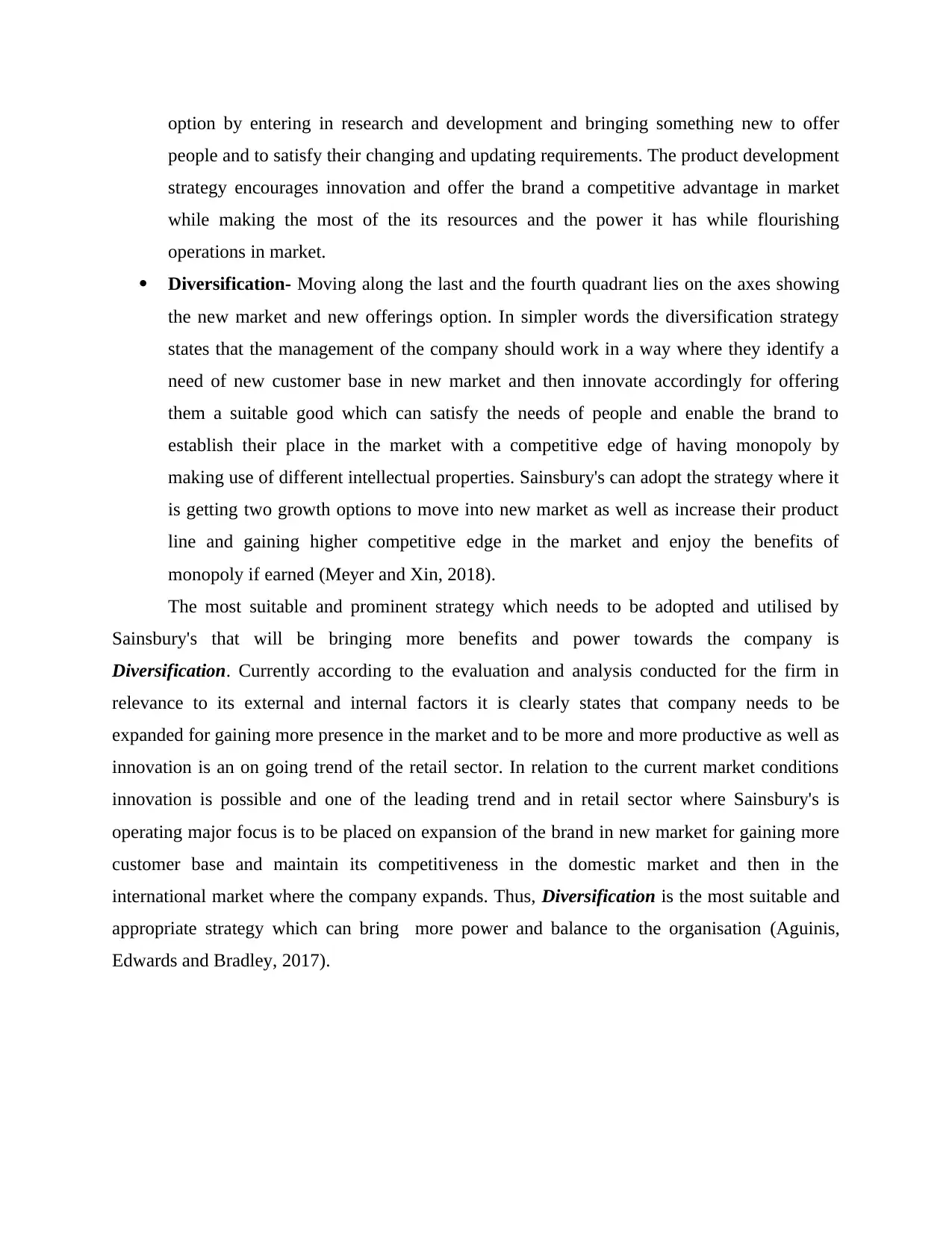
option by entering in research and development and bringing something new to offer
people and to satisfy their changing and updating requirements. The product development
strategy encourages innovation and offer the brand a competitive advantage in market
while making the most of the its resources and the power it has while flourishing
operations in market.
Diversification- Moving along the last and the fourth quadrant lies on the axes showing
the new market and new offerings option. In simpler words the diversification strategy
states that the management of the company should work in a way where they identify a
need of new customer base in new market and then innovate accordingly for offering
them a suitable good which can satisfy the needs of people and enable the brand to
establish their place in the market with a competitive edge of having monopoly by
making use of different intellectual properties. Sainsbury's can adopt the strategy where it
is getting two growth options to move into new market as well as increase their product
line and gaining higher competitive edge in the market and enjoy the benefits of
monopoly if earned (Meyer and Xin, 2018).
The most suitable and prominent strategy which needs to be adopted and utilised by
Sainsbury's that will be bringing more benefits and power towards the company is
Diversification. Currently according to the evaluation and analysis conducted for the firm in
relevance to its external and internal factors it is clearly states that company needs to be
expanded for gaining more presence in the market and to be more and more productive as well as
innovation is an on going trend of the retail sector. In relation to the current market conditions
innovation is possible and one of the leading trend and in retail sector where Sainsbury's is
operating major focus is to be placed on expansion of the brand in new market for gaining more
customer base and maintain its competitiveness in the domestic market and then in the
international market where the company expands. Thus, Diversification is the most suitable and
appropriate strategy which can bring more power and balance to the organisation (Aguinis,
Edwards and Bradley, 2017).
people and to satisfy their changing and updating requirements. The product development
strategy encourages innovation and offer the brand a competitive advantage in market
while making the most of the its resources and the power it has while flourishing
operations in market.
Diversification- Moving along the last and the fourth quadrant lies on the axes showing
the new market and new offerings option. In simpler words the diversification strategy
states that the management of the company should work in a way where they identify a
need of new customer base in new market and then innovate accordingly for offering
them a suitable good which can satisfy the needs of people and enable the brand to
establish their place in the market with a competitive edge of having monopoly by
making use of different intellectual properties. Sainsbury's can adopt the strategy where it
is getting two growth options to move into new market as well as increase their product
line and gaining higher competitive edge in the market and enjoy the benefits of
monopoly if earned (Meyer and Xin, 2018).
The most suitable and prominent strategy which needs to be adopted and utilised by
Sainsbury's that will be bringing more benefits and power towards the company is
Diversification. Currently according to the evaluation and analysis conducted for the firm in
relevance to its external and internal factors it is clearly states that company needs to be
expanded for gaining more presence in the market and to be more and more productive as well as
innovation is an on going trend of the retail sector. In relation to the current market conditions
innovation is possible and one of the leading trend and in retail sector where Sainsbury's is
operating major focus is to be placed on expansion of the brand in new market for gaining more
customer base and maintain its competitiveness in the domestic market and then in the
international market where the company expands. Thus, Diversification is the most suitable and
appropriate strategy which can bring more power and balance to the organisation (Aguinis,
Edwards and Bradley, 2017).
Paraphrase This Document
Need a fresh take? Get an instant paraphrase of this document with our AI Paraphraser
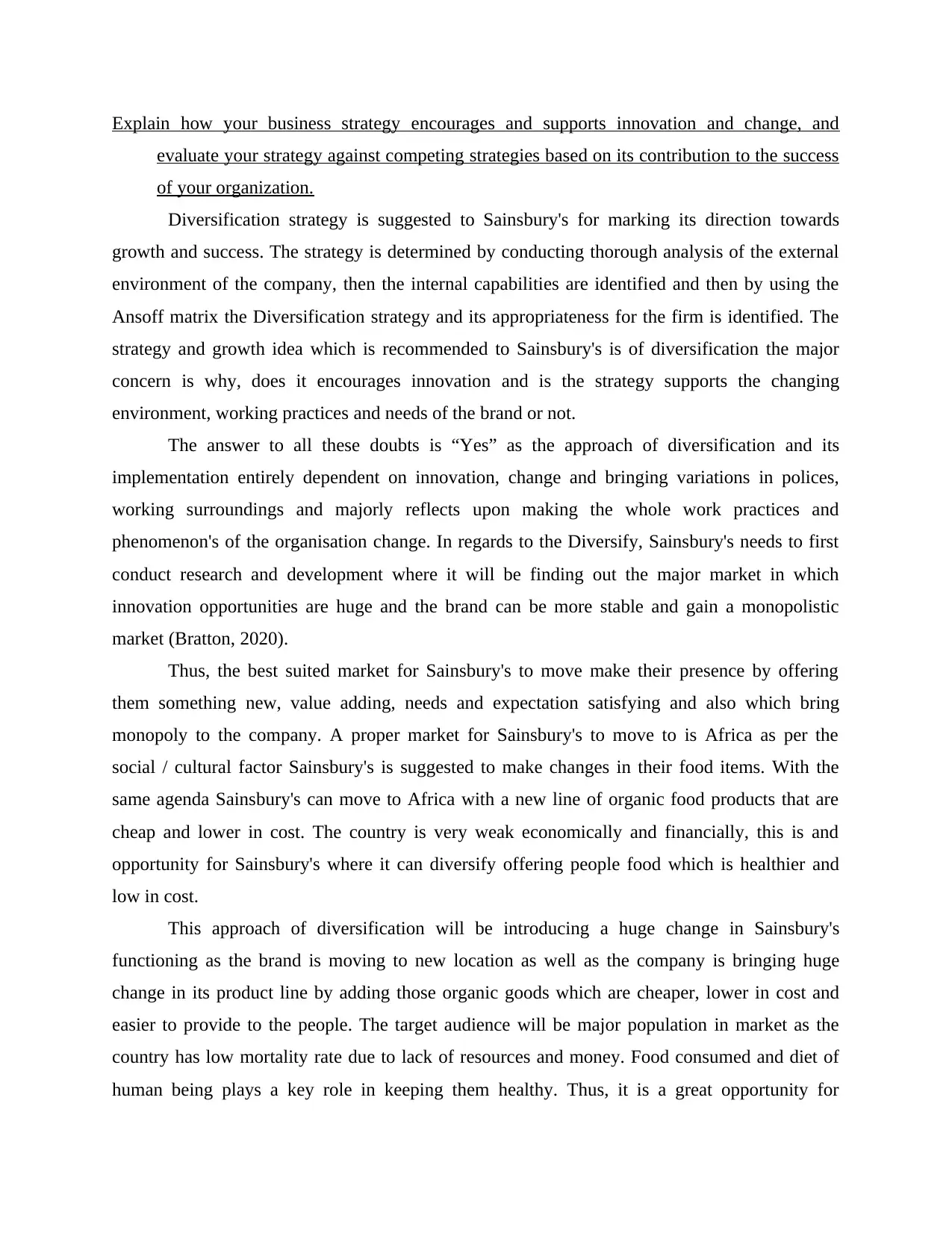
Explain how your business strategy encourages and supports innovation and change, and
evaluate your strategy against competing strategies based on its contribution to the success
of your organization.
Diversification strategy is suggested to Sainsbury's for marking its direction towards
growth and success. The strategy is determined by conducting thorough analysis of the external
environment of the company, then the internal capabilities are identified and then by using the
Ansoff matrix the Diversification strategy and its appropriateness for the firm is identified. The
strategy and growth idea which is recommended to Sainsbury's is of diversification the major
concern is why, does it encourages innovation and is the strategy supports the changing
environment, working practices and needs of the brand or not.
The answer to all these doubts is “Yes” as the approach of diversification and its
implementation entirely dependent on innovation, change and bringing variations in polices,
working surroundings and majorly reflects upon making the whole work practices and
phenomenon's of the organisation change. In regards to the Diversify, Sainsbury's needs to first
conduct research and development where it will be finding out the major market in which
innovation opportunities are huge and the brand can be more stable and gain a monopolistic
market (Bratton, 2020).
Thus, the best suited market for Sainsbury's to move make their presence by offering
them something new, value adding, needs and expectation satisfying and also which bring
monopoly to the company. A proper market for Sainsbury's to move to is Africa as per the
social / cultural factor Sainsbury's is suggested to make changes in their food items. With the
same agenda Sainsbury's can move to Africa with a new line of organic food products that are
cheap and lower in cost. The country is very weak economically and financially, this is and
opportunity for Sainsbury's where it can diversify offering people food which is healthier and
low in cost.
This approach of diversification will be introducing a huge change in Sainsbury's
functioning as the brand is moving to new location as well as the company is bringing huge
change in its product line by adding those organic goods which are cheaper, lower in cost and
easier to provide to the people. The target audience will be major population in market as the
country has low mortality rate due to lack of resources and money. Food consumed and diet of
human being plays a key role in keeping them healthy. Thus, it is a great opportunity for
evaluate your strategy against competing strategies based on its contribution to the success
of your organization.
Diversification strategy is suggested to Sainsbury's for marking its direction towards
growth and success. The strategy is determined by conducting thorough analysis of the external
environment of the company, then the internal capabilities are identified and then by using the
Ansoff matrix the Diversification strategy and its appropriateness for the firm is identified. The
strategy and growth idea which is recommended to Sainsbury's is of diversification the major
concern is why, does it encourages innovation and is the strategy supports the changing
environment, working practices and needs of the brand or not.
The answer to all these doubts is “Yes” as the approach of diversification and its
implementation entirely dependent on innovation, change and bringing variations in polices,
working surroundings and majorly reflects upon making the whole work practices and
phenomenon's of the organisation change. In regards to the Diversify, Sainsbury's needs to first
conduct research and development where it will be finding out the major market in which
innovation opportunities are huge and the brand can be more stable and gain a monopolistic
market (Bratton, 2020).
Thus, the best suited market for Sainsbury's to move make their presence by offering
them something new, value adding, needs and expectation satisfying and also which bring
monopoly to the company. A proper market for Sainsbury's to move to is Africa as per the
social / cultural factor Sainsbury's is suggested to make changes in their food items. With the
same agenda Sainsbury's can move to Africa with a new line of organic food products that are
cheap and lower in cost. The country is very weak economically and financially, this is and
opportunity for Sainsbury's where it can diversify offering people food which is healthier and
low in cost.
This approach of diversification will be introducing a huge change in Sainsbury's
functioning as the brand is moving to new location as well as the company is bringing huge
change in its product line by adding those organic goods which are cheaper, lower in cost and
easier to provide to the people. The target audience will be major population in market as the
country has low mortality rate due to lack of resources and money. Food consumed and diet of
human being plays a key role in keeping them healthy. Thus, it is a great opportunity for
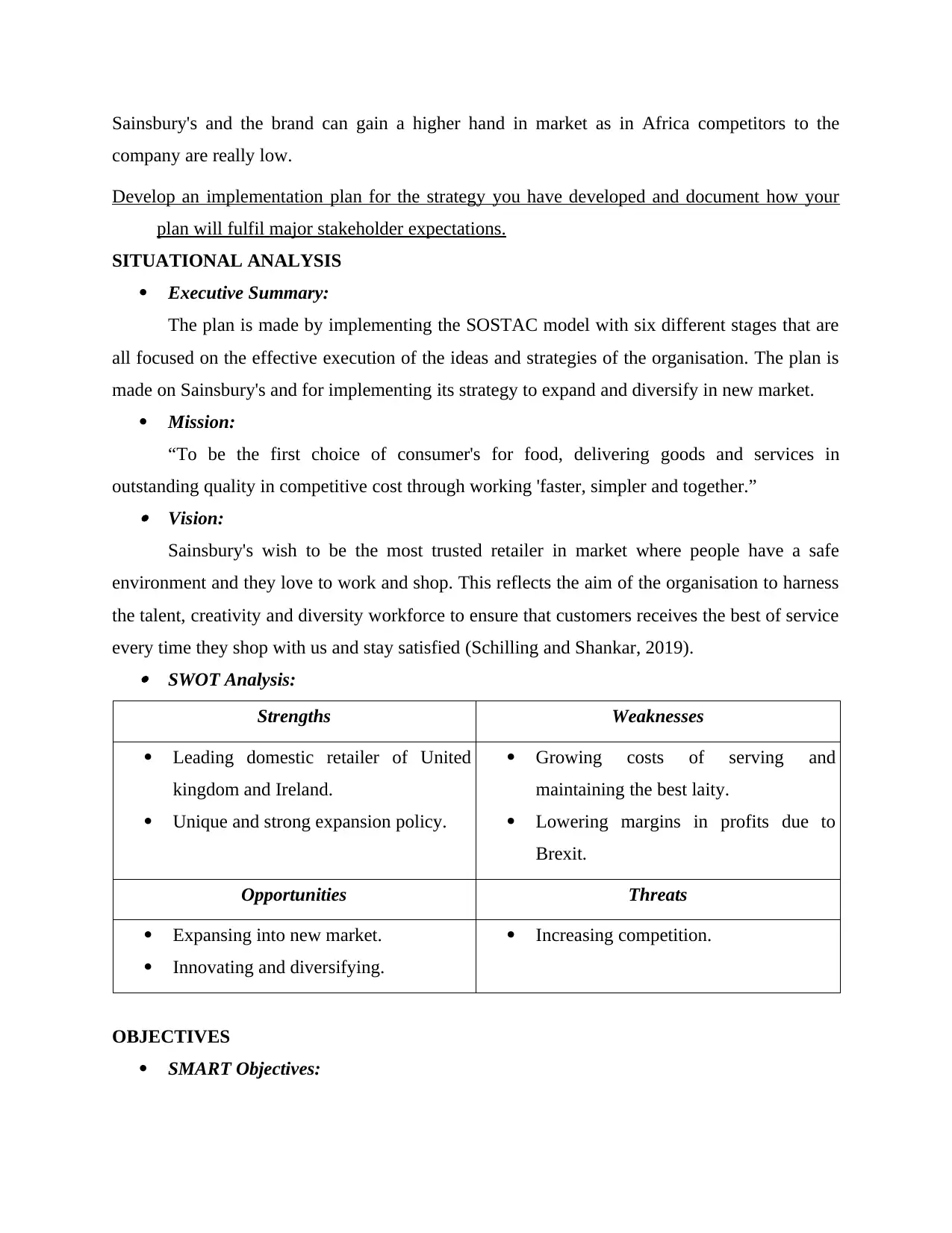
Sainsbury's and the brand can gain a higher hand in market as in Africa competitors to the
company are really low.
Develop an implementation plan for the strategy you have developed and document how your
plan will fulfil major stakeholder expectations.
SITUATIONAL ANALYSIS
Executive Summary:
The plan is made by implementing the SOSTAC model with six different stages that are
all focused on the effective execution of the ideas and strategies of the organisation. The plan is
made on Sainsbury's and for implementing its strategy to expand and diversify in new market.
Mission:
“To be the first choice of consumer's for food, delivering goods and services in
outstanding quality in competitive cost through working 'faster, simpler and together.” Vision:
Sainsbury's wish to be the most trusted retailer in market where people have a safe
environment and they love to work and shop. This reflects the aim of the organisation to harness
the talent, creativity and diversity workforce to ensure that customers receives the best of service
every time they shop with us and stay satisfied (Schilling and Shankar, 2019). SWOT Analysis:
Strengths Weaknesses
Leading domestic retailer of United
kingdom and Ireland.
Unique and strong expansion policy.
Growing costs of serving and
maintaining the best laity.
Lowering margins in profits due to
Brexit.
Opportunities Threats
Expansing into new market.
Innovating and diversifying.
Increasing competition.
OBJECTIVES
SMART Objectives:
company are really low.
Develop an implementation plan for the strategy you have developed and document how your
plan will fulfil major stakeholder expectations.
SITUATIONAL ANALYSIS
Executive Summary:
The plan is made by implementing the SOSTAC model with six different stages that are
all focused on the effective execution of the ideas and strategies of the organisation. The plan is
made on Sainsbury's and for implementing its strategy to expand and diversify in new market.
Mission:
“To be the first choice of consumer's for food, delivering goods and services in
outstanding quality in competitive cost through working 'faster, simpler and together.” Vision:
Sainsbury's wish to be the most trusted retailer in market where people have a safe
environment and they love to work and shop. This reflects the aim of the organisation to harness
the talent, creativity and diversity workforce to ensure that customers receives the best of service
every time they shop with us and stay satisfied (Schilling and Shankar, 2019). SWOT Analysis:
Strengths Weaknesses
Leading domestic retailer of United
kingdom and Ireland.
Unique and strong expansion policy.
Growing costs of serving and
maintaining the best laity.
Lowering margins in profits due to
Brexit.
Opportunities Threats
Expansing into new market.
Innovating and diversifying.
Increasing competition.
OBJECTIVES
SMART Objectives:
⊘ This is a preview!⊘
Do you want full access?
Subscribe today to unlock all pages.

Trusted by 1+ million students worldwide
1 out of 23
Related Documents
Your All-in-One AI-Powered Toolkit for Academic Success.
+13062052269
info@desklib.com
Available 24*7 on WhatsApp / Email
![[object Object]](/_next/static/media/star-bottom.7253800d.svg)
Unlock your academic potential
Copyright © 2020–2025 A2Z Services. All Rights Reserved. Developed and managed by ZUCOL.





